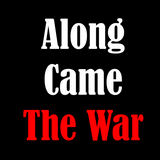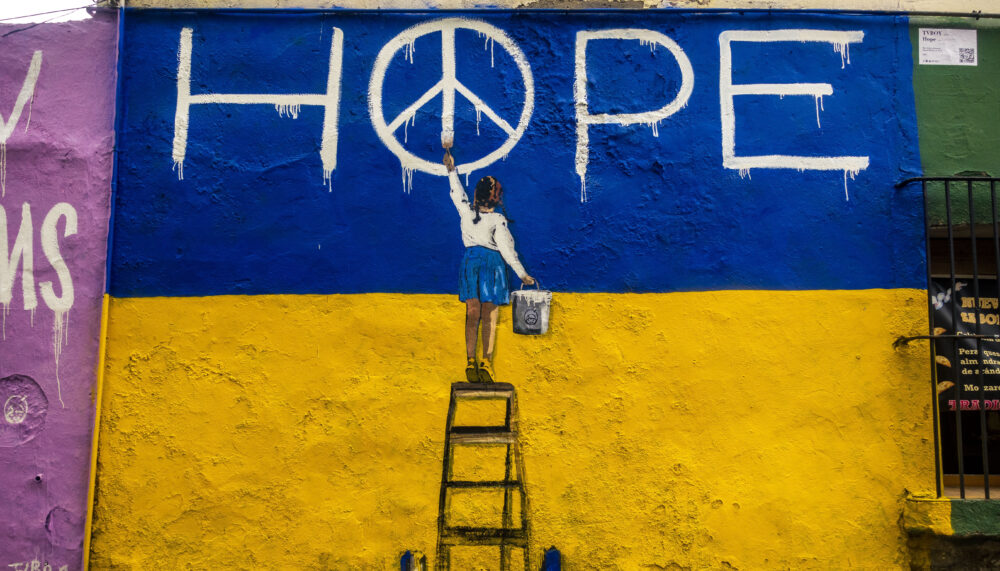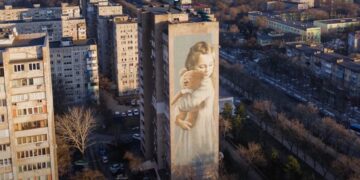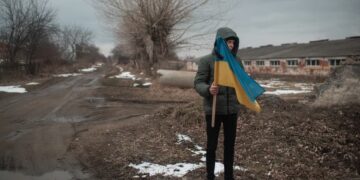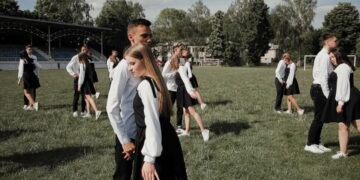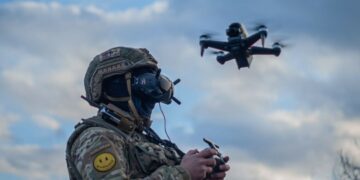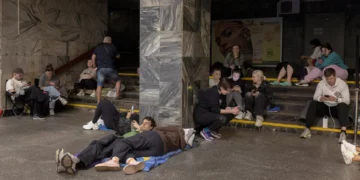We explore the evolving relationship between art and society. These reflections come at a very important moment when traditional artistic expression intertwines with digital innovation, and when art serves not merely as decoration but as witness, healer, and keeper of collective memory. Our students examine art’s multifaceted roles: as cultural ambassador, emotional conduit, historical document, and resistance against forgetting. They consider how art shapes identity and preserves heritage, particularly in times of crisis and war.
Maria Brui:
Art has shown the mentality of the timeline since the first day of humanity, and it still does, but in a new unique way.
These days art is different. The cause of it is not only the appearance of social media, but also the invention of artificial intelligence. It affects art more than we can imagine, as much as social media does. There are, of course, two sides of this phenomenon.
The first side is positive. Social platforms as TikTok and Instagram help young artists in finding their audience and clients. It also helps people, who are interested in art, to discover something new. The invention of AI makes human art more expressive and unique.
The second side is negative. Social media is great, but it gets more and more difficult to grow without posting. I know at least 10 people, who could be very popular with their art, but they don’t feel comfortable posting so much. It also creates “fake art”. Some people do art for likes, but it’s just a copy of other things. Artificial intelligence also affects art nowadays because people lose its purpose. Some start to appreciate human art more, as I said earlier, but others try to fake their art with AI or stop using human things.
To sum up, modern art has its pros and cons, but I think that it’s still beautifully. Those, who believe in humanity and their imagination will always appreciate art and find it astonishing. Our art is moving to the future, and it’s the whole point of it.
Lyubov Nurmakhamedova:
Throughout history, artists have held both sacred and societal responsibilities. In times when the majority of people could not read or write, visual art and storytelling served as powerful tools to educate the masses. Artists painted icons, illuminated manuscripts, and told religious and historical stories through images. They were also court painters, glorifying the achievements and authority of rulers, as well as craftspeople whose beautiful creations preserved cultural identity.
In the modern world, artists have become truth-tellers, visionaries, and provocateurs. They reflect on the state of the world, challenge societal norms, and spark change. Their canvases may now be digital or literary, their subjects political or deeply personal. Artists still move hearts, shape public opinion, and draw attention to injustice, but with broader platforms and louder voices.
Today, that role is especially vital in times of war. Ukrainian author Tamara Duda, who writes under the pseudonym Tamara Horikha-Zernia, is one such voice. Her novels “Docia” and “The Whisperer” (Sheptukha) are powerful literary responses to the full-scale russian invasion of Ukraine, offering a deeply human view of war for both Ukrainian and European audiences.
Docia, which won BBC Ukraine’s Book of the Year 2019, tells the story of an ordinary woman in Donetsk who becomes an unexpected hero as war erupts around her. She represents thousands of real Ukrainians—volunteers, medics, and everyday people—who chose resistance and courage over fear.
The novel has been widely translated and published in Poland (Córeczka, 2022), Sweden (2024), Spain (2023), as well as in English and German editions. Critics in Sweden and Poland praised its emotional power and authenticity, calling it a quiet but urgent portrait of resistance.
The novel also inspired the acclaimed solo theatre performance “A Simple Ukrainian Scythian Woman”, which toured Ukrainian cities and de-occupied territories. It won awards at international theatre festivals in 2023 and broadened the story’s reach.
Her second novel, The Whisperer, explores the inner wounds of war through mysticism, memory, and folklore. It shows how people endure and heal while preserving their cultural roots.
Tamara Horikha-Zernia’s work is more than literature—it is emotional diplomacy. Her characters allow European readers to understand Ukraine not through headlines, but through lived experience. She gives war a face, a voice, and above all, a soul.
As long as writers like Tamara speak, Ukraine’s story will be heard—and felt—far beyond its borders.
Martha Shvets:
Almost everything in my life is influenced by art. As a cultural studies student, I learn the history of painting, music, cinema, and literature daily. Moreover, I try to present myself as an artsy person, as well as my friends and university buddies. In our lectures, we talk a lot about the fact that art is everywhere one goes. That is probably the only thing that hasn’t changed in human lives through centuries. Nowadays, people create art for different purposes – some do it as a hobby, meanwhile, professional painters and sculptors make a living from their work. During war, art receives a whole new meaning. Painters reflect on horrible circumstances and crimes and save their feelings in the artwork. After that, other people can feel seen through the painting, because sometimes it’s impossible to just talk out what exactly one feels, especially at such a terrible time. Art also has a special mission – the next generations will have emotional artifacts from war victims. Future Ukrainians, for instance, will be able to at least partly understand what we had felt under russian attacks. Ukrainian galleries, museums, and art spaces, such as Mystetskyi Arsenal, Pinchuk Art Centre, and NAMU support artists by giving them a place to present and even create their work. The Khanenko Museum holds summer art academies for teenagers to make art – zines, paintings, collages. Tutors of these creative classes talk with teens about the role of art, and I believe that it is to save emotions in various ways. This is something that AI is not able to do – machines can only make something, not give it meaning. The role of artists is to make people reflect on their feelings – whether it’s an admiration of what they see or a criticism. Art doesn’t need to be likeable – it just has to impact us in any way.
Anna Haidai:
Art plays an active role in people’s lives. It doesn’t just exist alongside us and give us ideas. It thinks deeply about life, responds to what happens, and records feelings. This became very clear during the war.
Because art is all around us. Music started to show how people feel. For instance, Liza Bibikova sings about the pain of distance, Palindrom about needing a leader, and Artystka Chuprunenko about missing home. Jamala tells stories of loss, while Lely 45 shares the sad fates of children. Musicians react to today’s events and think about them again in the songs we listen to every day, maybe on the subway going to work or school.
Writers think about how the war affects us. They gather memories like little puzzle pieces. Books and writing are changing and becoming like broken pieces: we see this in Serhiy Zhadan’s collection “Arabesques,” books from the “Orlando” publishing house, and in Tetiana Kostina’s book of women’s thoughts “Strength Grew at the Breaking Point.”
Even art shows have changed their focus. More often we see events at Mystetskyi Arsenal and NAMU where things like darkness, living in basements, the sound of sirens, and death are rethought.
I don’t know how we could remember so much if art wasn’t here to help. People’s minds often try to forget bad things so they can keep going. But we must remember what russia is doing. This is very important for our survival. Art helps a lot with remembering.
Alina Hostar:
The role of artist in Ukrainian society hasn’t changed quite much, actually. Ukrainian artists are the face of our nation, of our country. Their most important mission is to represent our culture and share it with the world. In the modern world there is a real power in culture: economical, political and even military. When we lack other resources, art becomes the most important factor to show up, to be seen.
There is also a role of art inside the country, which is to rule the masses. Art brings feelings and moods, so to function more properly we need to evoke special feelings such as love towards our culture or hate towards Russian culture that was an oppressor for so many years. Art leads us through hard times, cheers us up, or reminds us of our everyday struggles.
Anna Bryndzia:
Art is an important part of my life, since I like to gather inspiration from different sources and find something beautiful in many things. The way I perceive art is reflected in my worldview, style and in what I create myself. This topic is complicated for me because I like drawing and was into this since childhood, but I always question myself whether there’s any way to create something that the world has never seen before and will never after. The greatest drawings, pictures, literature and cinematography works are, in my opinion, created by people who made an inimitable innovation that impacted history in cultural contexts. Modern art is something I truly adore because creative people find ways to create unique art pieces in the times of Artificial Intelligence, online overload of visuals and other dangerous stuff. While all this, creators still find new ways to make something absolutely new out of the technologies we have today, creating new techniques and styles which inspire so much.
Victoria Romas:
In my opinion, today the role of an artist is to reflect what is happening in the world. Artists have the talent and tools to speak, to express their thoughts and impressions, which will be close to other people. Also, an artist is a person who represents culture, and therefore moral values too.
It seems like the role of an artist is to be seen as an example of the best version of a person, and people will involuntarily emulate an artist. As a public person, an artist must understand his or her responsibility for the narratives he or she brings to the media space. In general, an artist is someone who demonstrates culture, someone who creates it.
Therefore, I believe that the main role of an artist has always been and will always be the same – to create art as part of culture.
Maria Shcherbyna:
I strongly believe, art can influence people a lot, as long as it tells the story in it’s a own way, in such a language that everyone would understand through the feelings and emotions, not through the rational thinking. Nowadays, there is a lot of information around, so the educating role of artist is now not really functional. It is more about finding the right information in an endless amount of it. I think, an artist helps to see the world differently, from another perspective. Artists also talk to people in a certain way, unique and sometimes much better understandable than real language. It gives us an opportunity to find the most important events, stories, characters and to understand them. Our life is now extremely rational, there is often no time for feelings. And I believe, the role of an artist is nowadays to give us opportunities to feel, to live through emotions, to see something more in even everyday life.
